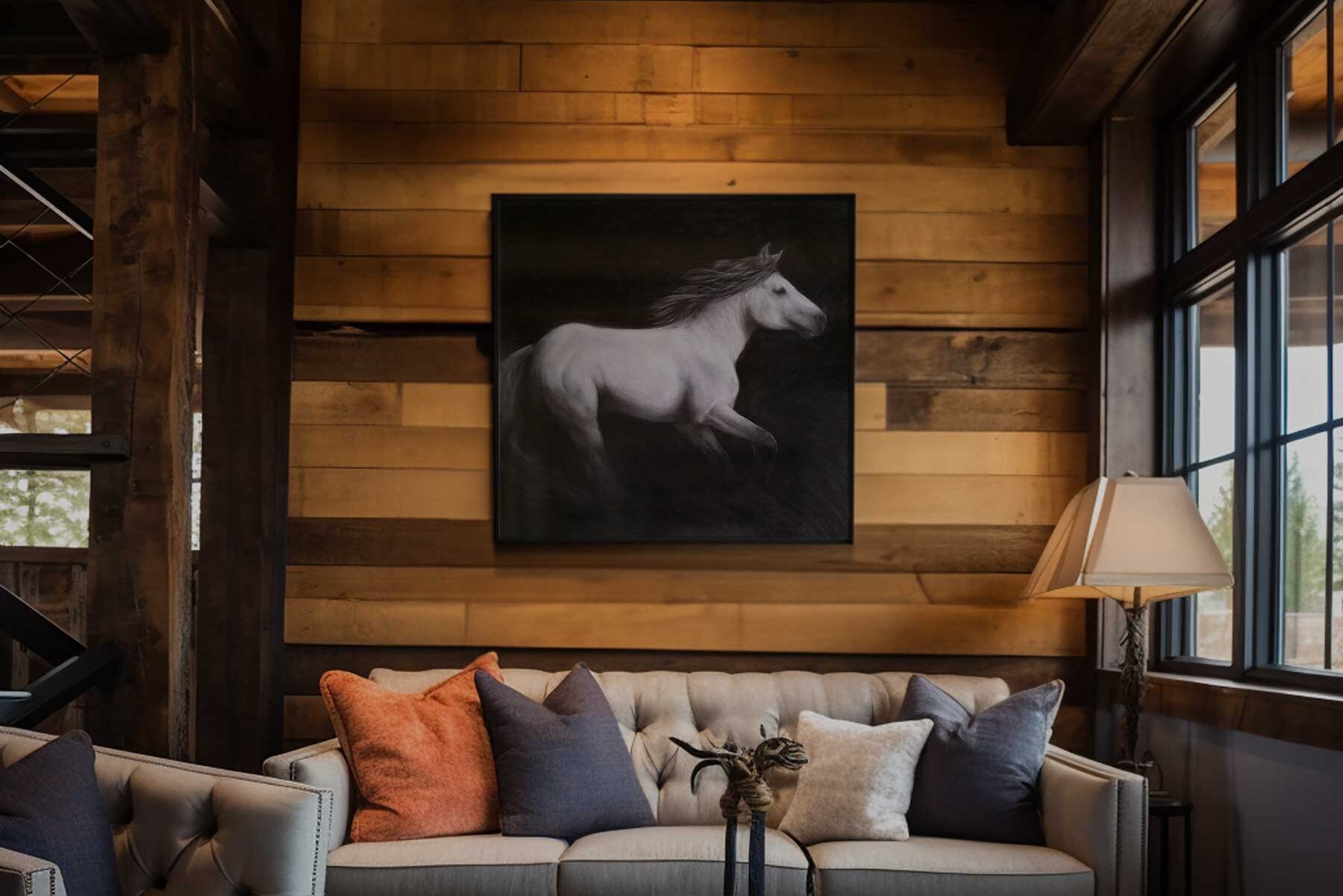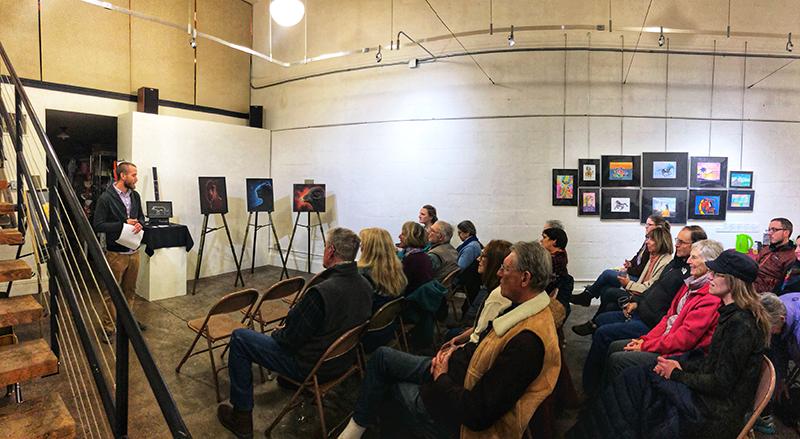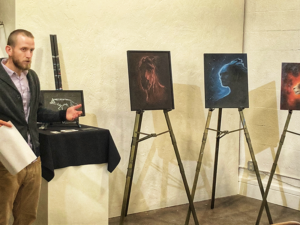The following is an excerpt from an invitation-only exclusive art talk and exhibition preview event from December 6, 2018. I discuss, among other things, the inspiration behind my upcoming show on January 11, 2019, entitled ‘Virgin Land: Myths & Narratives‘.
Tonight I’m here to talk to you about narrative, about how it affects the course of our lives and why we need to seriously rethink the stories we tell ourselves. I put to you that much of what we tell ourselves about who we are and why is not serving us, our country, humanity or the world all that well.
Now I know a few of you must be wondering what a visual artist could possibly have to say about narrative. After all, I spend my days in the studio making pictures, right? It’s true, I don’t pretend to be an expert on the craft of storytelling or writing, but I do happen to know something about narrative. Actually, we all do. All of us. Inherently. We are all, in our own ways, experts on narrative because our minds are built to think in terms of narrative.
Now, what does that mean? And why does that matter?
Well, let’s begin with why it matters.
It matters because narrative is the mechanism by which we come to believe in what we do, and how we find our place in the world — it is how we know what is right and what is wrong, it is how we know who our people are, who to love, who to hate… and when to kill. In other words, narrative guides our actions… and this happens for better or worse in matters that are both large and small — in matters of state and in our daily lives. Narrative is how our mind makes sense out of a complicated world that is rich with sensory experiences. It is ever present, like life itself.
Think about it like this: if our minds lacked this mechanism of narrative life would become, in the words of one researcher, ‘just one damn thing after another.’ We would lose context. We would lose meaning. Think about that for a moment: life would lose its meaning.
So really, when I talk about narrative I’m referring to a contextualizing process, a method by which we construct meaning, a sequential ordering that keeps us aligned in the face of overwhelming stimuli. It’s this process, and the fact that we can do it in such a sophisticated manner, that has helped place our species at the level that it’s at. Other species communicate, other species have the capacity to learn and feel and mourn and express joy. Many species have what could be called a creative spark, but ours is the only species that possesses what some scholars call the ‘literary mind’, which is to say an ability to construct narrative. Story is central to our success as a species. Narrative thought is what makes everyday thought possible.
Imagine a room full of screaming toddlers. Imagine that. The noise, the cacophony. To offer a metaphor, narrative thought is like a summary transcript taken from that room, as though a court stenographer had been there to record it. What had been a loud zoo is now orderly, sequential, comes formatted in a way that makes it easy for us to understand — and aligns with a worldview that makes sense to us. Piece of cake.
Sounds great, right?
Here’s the rub. That process, though it keeps us from going completely insane, can also be dangerous.
Edward Bernays, the man who literally wrote the book on propaganda, and whose work, by the way, paved the way for modern marketing, described this process of parsing and contextualizing as ‘stereotyping.’ That says a lot, doesn’t it? We’re all familiar with that term, aren’t we? Stereotyping, the oversimplification of an idea. The neuroscientist Gregory Berns says “the brain is fundamentally a lazy piece of meat… it doesn’t want to waste energy.” Stereotyping, oversimplification — these are the brain’s way of creating more efficient pathways. It’s an important function, but it can get us into trouble.
We use that very same process of oversimplification to justify not only killing, but oppressive economic policies and social norms, the improper and devastating use of land and natural resources, and political violence, just to name a few things.
The stories we tell ourselves about our place in the world matter. The stories we tell ourselves about where others sit in relation to ourselves matter. These stories direct us. And they are not always right. They can be downright false, and they can send us down dark paths. A virtuous person can perform atrocities if given the right story. This is a reality we see all too often, unfortunately, and the reason is that we rarely stop to reflect on our personal narratives. And why should we? If we possess a worldview that makes sense, in which everything falls into place — a story that feels comfortable… what incentive do we have to question it? Doesn’t it seem a little crazy to investigate what we already know to be true to determine if it is actually true? Yes, of course! But when we understand the process by which our mind parses incoming stimuli to create a digestible construct of the world, we realize that what we think is a simple truth probably isn’t. This is why we need to rethink the stories we tell ourselves because we’re doing ourselves and those around us a disservice by sticking to our guns.
One of my most important roles as an artist is to act as a mirror for society, to provide a space for reflection. The objective of my upcoming show in January is to facilitate this type of reflection — on narrative — specifically on the mythos unique to the American West.
The pieces you see displayed tonight are from a segment of the show entitled ‘The Howling Wilderness.’ That title was taken from the work of a New England Puritan minister, who wrote this of the American West in 1662:
A waste and howling wilderness,
Where none inhabited
But hellish fiends, and brutish men
That devils worshiped.
At the time of his writing, before westward expansion, this was the prevailing sentiment about the mysterious territory to the west. You can find in his words a visceral fear — fear of the unknown, the unseen… fear of that and those who dwell there. Later, as we all know, the narrative evolved into an invitation, where before the unknown should be avoided it later became something to be claimed and conquered. But fear remained part of the narrative. The acts of a conqueror have always found their foundation in fear because in conquering something you are fundamentally changing its nature to align with yours; its separateness, its strangeness is something that cannot be tolerated. That and those who resist are violently put down. Why? Because, as we’ve already established, we rarely stop to rethink the stories we tell ourselves about who we are. A conqueror is driven by certainty awarded him by a world-view and a narrative that makes sense to him. That which does not conform is seen as a threat.
The pieces on display here tonight were designed to reflect the same mystery, the same obscurity, and a similar binary notion about that and those who existed beyond and in the unknown. They are meant to feel bold, yet somehow incomplete. They are meant to instill a certain level of uncertainty. In order to achieve this, I employ a process that is a mix between the highly coordinated and constructed method of a classical painting process with that of the emotional and improvisational methods employed by more modern abstract expressionists. I try to capture the dichotomy between clarity of form and the wildness of spontaneity by employing techniques of tight rendering alongside loose brushwork and random effects like spatter. The idea is to capture elements that are almost contradictory, elements that force a reconciliation of a sort.
But above all, these pieces and the methods I employ to create them are meant to facilitate reflection.
They are meant to challenge our internal narrative mechanisms.
 The remainder of my January show features a progression of several additional narratives familiar to the western mythos, including a segment I’ve entitled ‘Untransacted Destiny and the Garden of the World’, which is about the romanticized notions of appropriation and the commodification of land, followed by a section entitled ‘Dime Novel Hero’, featuring visions of masculinity. The final section I’ve named ‘A Fourth Song’, which is taken from an American Indian myth about remaking the world. It features artwork that speaks to transitions and transformation, a sort of call to action, the goal of which is to inspire hope for the future — hope that we can learn from what has transpired and use that wisdom to make a better tomorrow.
The remainder of my January show features a progression of several additional narratives familiar to the western mythos, including a segment I’ve entitled ‘Untransacted Destiny and the Garden of the World’, which is about the romanticized notions of appropriation and the commodification of land, followed by a section entitled ‘Dime Novel Hero’, featuring visions of masculinity. The final section I’ve named ‘A Fourth Song’, which is taken from an American Indian myth about remaking the world. It features artwork that speaks to transitions and transformation, a sort of call to action, the goal of which is to inspire hope for the future — hope that we can learn from what has transpired and use that wisdom to make a better tomorrow.
The stories we tell matter. They matter.
If we adhere to a particular narrative, if we have a certain theory about the world that we believe in — that we believe is objectively and unequivocally true — it must logically follow that theory of the world must be true for all observers, regardless of their perspective, regardless of party, religion, sex, age, ethnicity or social standing. But can we honestly say that about our narratives?
If we are to best serve ourselves, our families, our society and our world, we must seriously rethink the stories we tell ourselves. If we truly value justice, if we truly value equality, if we truly value freedom, it is necessary that we do so. It is my sincere hope that my upcoming show in January will provide a place for the kind of reflection necessary to do so — and it is my hope that it provides a space where we can all begin the work of building new, more equitable, stories for the future.


